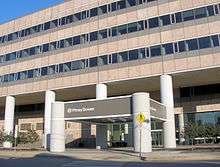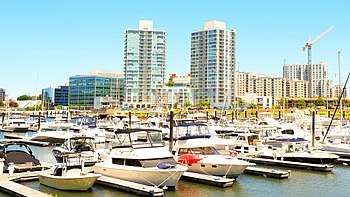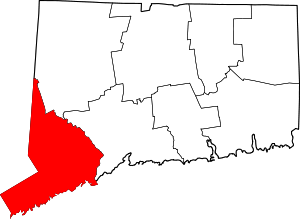South End of Stamford
The South End of Stamford, Connecticut is a rapidly growing neighborhood located at the southern end of the city, just south of the Downtown neighborhood. It is expected to be greatly changed with redevelopment over the next decade, including the massive Harbor Point redevelopment. The South End is a peninsula bordered by Stamford's Central Business District and Interstate 95 to the North and almost totally by water on all other sides (Stamford Canal to the East and the Rippowam River to the West), with few streets linking it to other neighborhoods. It contains some industrial tracts, several old factory buildings, many small homes and apartment buildings, and a number of office buildings. Most of the neighborhood has been designated as the South End Historic District which is listed on the National Register of Historic Places. A high-risk flood zone, Stamford's South End is the location of the Stamford Hurricane Protection Barrier, operated by the U.S. Army Corps of Engineers.
South End Historic District | |
Atlantic Street in the South End with many elements of the neighborhood: empty lot, modest homes and businesses, Pitney Bowes modern office building and, in upper lefthand corner, the end of the defunct Yale & Towne factory building | |
  | |
| Location | Roughly bounded by Metro-North Railroad tracks, Stamford Canal, Woodland Cemetery, and Washington Blvd., Stamford, Connecticut |
|---|---|
| Coordinates | 41°2′47″N 73°32′27″W |
| Area | 177.1 acres (71.7 ha) |
| Built | 1868 |
| Architect | Multiple |
| Architectural style | Colonial Revival, Late Victorian, Mixed (more than 2 styles from different periods) |
| NRHP reference No. | 86000472[1] |
| Added to NRHP | March 19, 1986 |
Historic district
The South End Historic District covers a 177.1-acre (71.7 ha) area of the South End neighborhood.[1] The district includes 449 buildings, most dating from the 1870s to the 1930s, and also "an early naturalistic cemetery, and an iron bridge."[2]:2
The Yale & Towne Lock Works was a major manufacturer which, along with other industry in the area, provided employment and shaped the neighborhood. The oldest structure in the district is the Peter DeMill House. Other notable buildings are Number 715 on Atlantic Street, a tenement building, and the Holy Name Rectory. The historic district includes the Pulaski Street Bridge, a wrought-iron lenticular through-truss bridge over the Rippowam River.[2]:8
History
The South End was one of the first sections of Stamford to be cleared and held in common by the original settlers from 1641 to 1665. By 1699 it and other sections of the town had been apportioned to individual land owners.[3]
"The area of Stamford known for many years as Hoytville was owned by George Hoyt, a real estate agent and the largest property owner in the city in the 1870s," wrote Susan Nova in an article in The Advocate of Stamford.[4] The South End was the manufacturing heart of the city in the nineteenth through mid-twentieth centuries. Most of the South End, previously owned by Greenwich-based Antares, which began a multi-use project on 82 acres (330,000 m2) "...abruptly handed the project it spearheaded to Building and Land Technology L.L.C. BLT signed on to the $3 billion-plus project earlier [in 2008] as a co-developer, and announced a $200 million recapitalization of the project," according to the Fairfield County Business Journal. "They showed great vision in assembling and entitling such an extraordinary piece of ground," said Carl Kuehner III, chief executive of BLT, in a prepared statement announcing the change. "Harbor Point incorporates the best in innovative urban design, community planning and technologically advanced environmental design."[5]
Linus Yale Jr. introduced some combination safe locks and key-operated cylinder locks around 1862. Then in 1868, he and Henry Robinson Towne founded the Yale Lock Manufacturing Company in the South End to produce cylinder locks. Yale died later that year. The Yale & Towne lock company manufactured locks there (giving Stamford its early nickname, "Lock City"). And other manufacturing businesses were sited there.
In 1938, the neighborhood was severely flooded by a hurricane that swept through southern New England. Since then, barriers have been constructed in Stamford Harbor to prevent similar flooding. About 600 acres of downtown Stamford is now protected by a two-mile-long barrier system built in 1969 by the Army Corps of Engineers, that "helped prevent about $25 million in damage" during the 11 food storm surge of Hurricane Sandy.[6]
As of 2018, many corporations have moved to Stamford's South End, particularly in the Harbor Point area. Major corporate headquarters include Charter Communications, KAYAK.com, Starwood Hotels & Resorts (now a major Marriott International office), Design With Reach, Centerplate, Thomson Reuters, Daymon Worldwide, High Ridge Brands, and Rhone Apparel, as well as major offices of Bridgewater Associates, and McKinsey & Company.
Pitney Bowes

The Pitney Bowes Corporation has a long history in the South End. In 1917, Walter Bowes moved his operations there, and in 1920 combined his firm with another to form Pitney Bowes. The company had manufacturing operations in the neighborhood for decades and its 422,000-square-foot (39,200 m2) corporate headquarters is located at the southern end of the triangular peninsula at 1 Elmcroft Road, where about 550 people worked.[7] Pitney Bowes sold their headquarters building to BLT in 2015, and moved their headquarters to Summer Street in Stamford. The building has been re branded as Silicon Harbor to attract startups to the area.[8]
April 2006 fire
The biggest fire in Stamford's history started on April 3, 2006 in Building 15 of the old Yale & Towne factory buildings. The fire spread to another, 17,500-square-foot (1,630 m2) building housing several antiques dealers. Dark clouds of smoke formed over the scene, visible from miles away. About 200 residents from homes on Pacific and Henry streets were evacuated. The biggest casualty was a firefighter who suffered a minor knee sprain.[9]
Stamford Fire Rescue Department Firefighters used 1 million gallons of water in three hours. Then the water mains ran out and water from the nearby harbor had to be pumped in to douse the flames. The fire department spent $25,000 in overtime to put out the fire.[9][10]
The complex at 735 Canal Street had been rented out by Antares Investment Partners of Greenwich to various businesses, including about 100 antiques dealers.[10]
The blaze started as a fire on a workbench in a piano shop, although city fire marshals never determined the exact cause.[9] City investigators found Antares had not fixed the sprinkler system, although it knew the system was broken when it bought the building in October 2005 from Heyman Properties of Westport. To fix it would have required cutting off the heat in the building as a new heating system was installed, and Antares was waiting until later in the spring or summer for that, Bruce Macleod, operations chief at Antares, had said, according to The Advocate, Stamford's daily newspaper. Heyman officials knew of the sprinkler system problems "and did nothing to fix them for years, the city's chief fire marshal said in April," The Advocate reported. The sprinkler system had broken in the 1990s, when heat was turned off in vacant parts of the building, causing water in the sprinkler system to freeze, cracking the pipes.[10]
The antiques dealers filed a class-action lawsuit against Antares and the piano shop in July 2006.[10]
Redevelopment plans

The Stamford train station and train tracks, along with Interstate 95, separate the South End from Downtown Stamford. Since 2000, real estate near train stations in southwestern Connecticut has been recognized as valuable for office and residential space, and plans are underway for several office buildings near the station in the South End.
In 2008, Building and Land Technology (BLT) purchased 82 acres (330,000 m2), roughly the northern half of the South End, including both the old Yale & Towne site and the site of the former coal gasification plant off Washington Boulevard from Antares. The "Lofts at Yale and Towne", as they are now called, opened in May 2010, on property that once was part of the Yale lock factory located on Henry Street.[11] In mid to late 2010 buildings at 100 and 101 Washington Boulevard were completed and are now home to the luxury apartment complex 101 Park Place and the new office headquarters of Building and Land Technology.[12]
The 20-acre (81,000 m2) Yale & Town site will have 300,000 square feet (30,000 m2) of retail space in new buildings off Canal Street, along with the 225 apartments at the "Lofts at Yale and Towne" located in a century-old, six-story factory building on Henry Street, according to plans Antares presented to the city Zoning Board in early 2007.[13]
About 4,000 housing units are planned for the development, along with some retail and office space. Antares had originally said the retail space in its plans was only to service the South End neighborhood, but in summer of 2006 it submitted a proposal to the city Planning Board for 500,000 square feet (46,000 m2). The Downtown Special Services District objected, and officials of that organization told the Planning Board at a hearing on August 10, 2006 that the retail space could hurt Downtown stores.
In 2009, Pitney Bowes paid an engineering consultant to study traffic in the South End, particularly in connection with plans for new office buildings and residences. According to the study, the new developments will clog traffic in the neighborhood, even with the planned improvements to Washington Boulevard and Atlantic Street (including reconstruction of the railroad underpasses of Atlantic and Canal streets) in the South End.[7]
Fire Department
The Stamford Fire Rescue Department's Fire Station # 2 serves the neighborhood.
In popular culture
- Part of Elia Kazan's 1947 film Boomerang was shot in the South End, particularly at St. Luke's Chapel, and nearly all of the rest of the movie was shot in Stamford, especially the Downtown section.[14]
- The musicians Moby and Battery Jackson once lived in some of the abandoned factory space in the South End.
In the South End

- Koscusko Park, a city park — at the southern tip of the peninsula
- CTE Inc., an anti-poverty agency — 34 Woodlawn Avenue
- South End Branch of Ferguson Library — 34 Woodlawn Avenue
- Ponus Yacht Club
- Woodlawn Cemetery, a large, old cemetery — in the southeast part of the neighborhood
Footnotes
- "National Register Information System". National Register of Historic Places. National Park Service. March 13, 2009.
- Nils Kerschus and John Herzan (August 1985). "National Register of Historic Places Inventory-Nomination: South End Historic District". National Park Service. and Accompanying 24 photos, from 1984 and 1985
- Feinstien, Estelle S., Stamford: From Puritan to Patriot 1641-1774, published by Stamford Bicentennial Corporation, 1976, page 20
- "A part of Stamford history is for sale," by Susan Nova, special correspondent, The Advocate, Real Estate section, August 4, 2006, accessed August 5, 2006. (The Advocate tends to remove articles off its web site after a week.) The article appeared on page R1; the quoted material on page R4; the article was about the Scofield-Hoyt house on Eden Road, not in the South End.
- Fairfield County Business Journal, Antares Pulls Out of Harbor Point, By Alexander Soule. Published Sept. 8, 2008
- Navarro, Mireya (2012-11-07). "Weighing Sea Barriers as Protection for New York". The New York Times. ISSN 0362-4331. Retrieved 2020-01-24.
- Cassidy, Martin B., and Elizabeth Kim, "Traffic could hinder renewal: Study: South End congestion is likely", The Advocate of Stamford, Connecticut, p 1, October 13, 2009
- "BLT-owned Stamford office complex awaits transformation". Stamford Advocate. 2017-08-13. Retrieved 2018-09-25.
- Lee, Natasha, "South End blaze costs millions: Antiques dealers still displaced after fire", article in The Advocate of Stamford, December 31, 2006, pp. A3, A7
- "Class-action lawsuit filed over Yale & Towne fire: Nearly 100 Antique dealers say owners failed to meet fire codes," article by Zach Lowe. The Advocate, Stamford, CT. July 24, 2006, pp. 1, A4
- The New York Times, By SANA SIWOLOP Published: December 7, 2010
- Stamford Advocate, Amid signs of a strong rental market, another housing complex at Harbor Point opens its doors, By Elizabeth Kim Published: Monday, September 27, 2010
- Dalena, Doug, "Zonking Board hearing on South End plan is delayed", news article in The Advocate of Stamford, pp A7, A8, Stamford Edition, May 14, 2007
- Russell, Don, "'Roles' in movies are nothing new for city: Kazan used Stamford in the '40s", editorial page column in The Advocate, Stamford edition, page A10, April 25, 2007
External links
In the South End
- South End Neighborhood Revitalization Zone
- Ponus Yacht Club
- CTE Inc., an anti-poverty agency
- Ferguson Library South End Branch
- "Made In Stamford - A History of Stamford as a Manufacturing Center". Made In Stamford. Archived from the original on October 25, 2005. Retrieved September 6, 2005.


